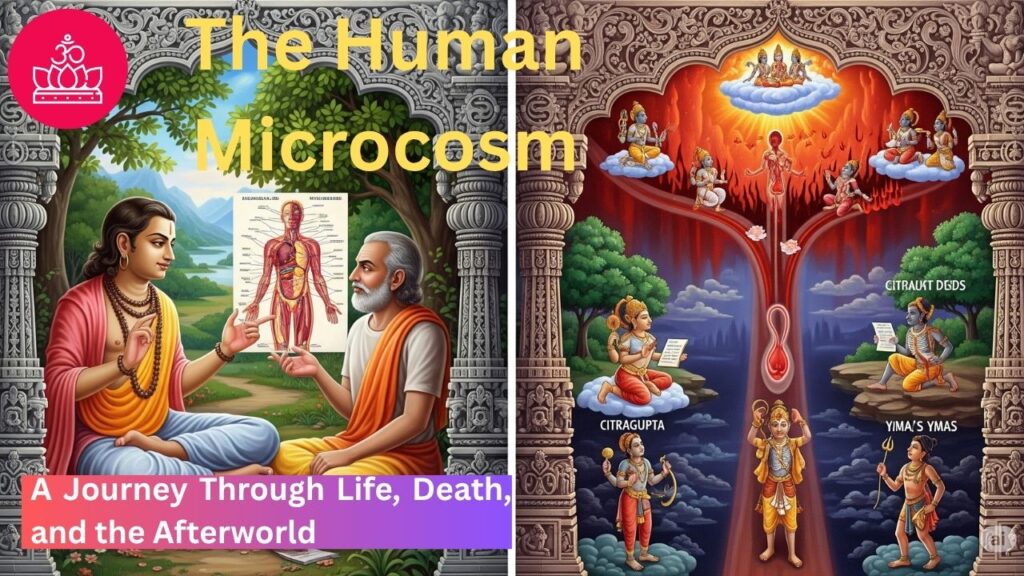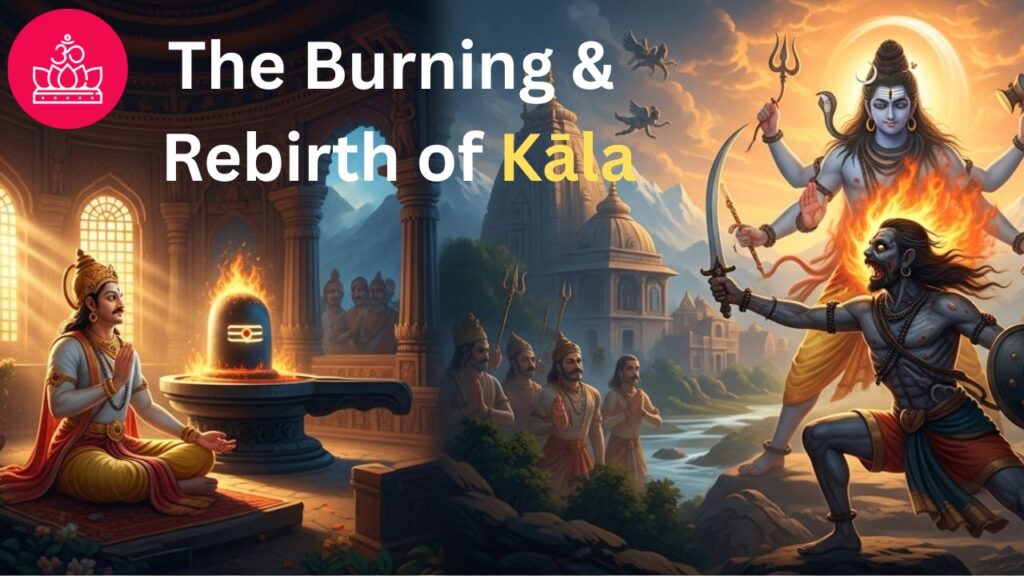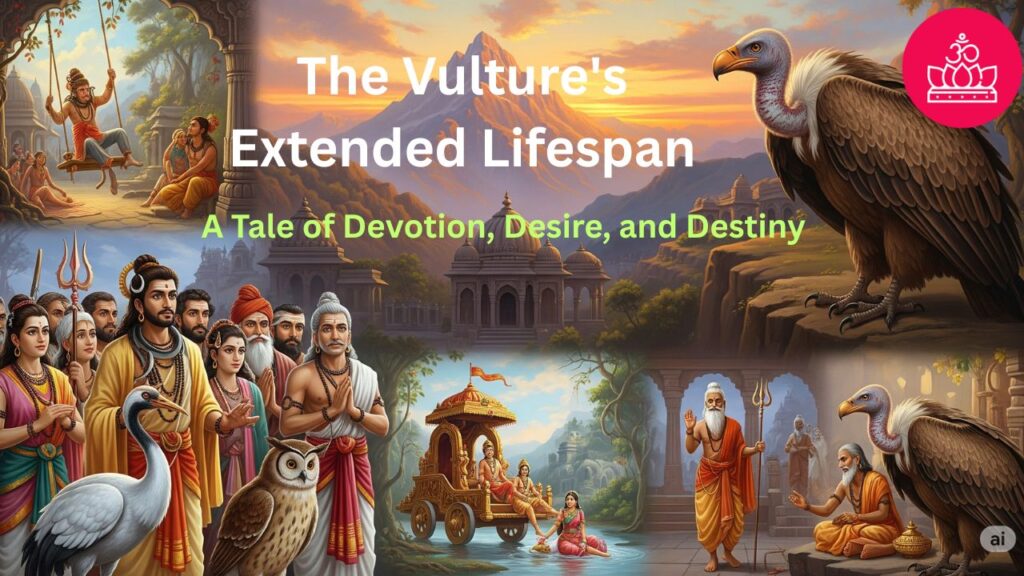The Human Microcosm: A Journey Through Life, Death, and the Afterworld
As told in: Skanda Purana – Kaumarika-khanda of the Maheshvara-khanda – Chapter 50: Departure of the Soul to the Next World
This chapter of the Skanda Purana unveils a profound cosmology, intricately weaving together the human body, the cosmos, and the journey of the soul after death. It’s a captivating narrative, rich in detail and imbued with the wisdom of ancient Hindu philosophy. The dialogue unfolds between Kamaṭha, a wise youth, and a learned guest, exploring the intricacies of human existence and the consequences of our actions.
# The Body: A Miniature Universe
The conversation begins with a fascinating analogy: the human body as a microcosm of the universe. Kamaṭha eloquently describes the body’s correspondence to the seven lokas (planes of existence) in Hindu cosmology. The soles of the feet represent Pātāla (the netherworld), progressing upwards through Rasātala, Talātala, Mahātala, Sutala, Vitala, and Atala, culminating in the head as Satyaloka (the highest realm). Each part of the body, from the navel representing the earth to the eyes symbolizing the Tapas Loka (world of austerity), mirrors the cosmic order.
This detailed anatomical description isn’t merely a physical inventory. It’s a profound statement about the interconnectedness of the individual and the cosmos. The human body, in its complexity, reflects the vastness and intricacy of the universe itself. This analogy underscores the inherent divinity residing within each individual, a reflection of the cosmic energy that permeates all existence. The seven dhātus (essential bodily constituents) – skin, blood, flesh, suet, bones, marrow, and semen – further emphasize the body’s intricate structure, mirroring the seven continents of the earth. The sheer number of bones, vessels, and hairs detailed (360 bones, 3,056,900 vessels, and 35 million hairs) highlights the body’s marvelously complex design, a testament to divine craftsmanship.
The description extends to the vital organs, the circulatory system, and the subtle energies that govern the body. The heart, with its lotus-like structure, becomes the central point of energy flow. The three intestines, their lengths varying in men and women, are a further illustration of the specificities of embodiment. The positioning of the spleen and liver, the description of the marrow cavities, and the detailed explanation of bodily fluids all contribute to a comprehensive understanding of the physical form as a complex, integrated system.
# The Subtle Energies: Prāṇa, Agni, and Soma
The discussion then delves into the realm of subtle energies that sustain the body. Prāṇa, Apāna, Samāna, Udāna, and Vyāna – the five vital airs – are described with their specific functions. Prāṇa governs breath and ingestion, Apāna handles elimination, Samāna manages digestion and assimilation, Udāna controls speech and other bodily functions, and Vyāna pervades the entire body, facilitating growth and various physiological processes. This description goes beyond a simple physiological explanation. It signifies the importance of balancing these subtle energies for maintaining both physical and spiritual well-being.
The five forms of Pāvaka (fire) – Pācaka (digestion), Rañjaka (blood formation), Sādhaka (mental activity), Ālocaka (vision), and Bhrājaka (skin radiance) – highlight the transformative power of energy within the body. Similarly, the five forms of Soma (moon energy) – Kledaka (lubrication), Bodhaka (taste perception), Tarpaṇa (nourishment), Śleṣmaṇa (mucus production), and Ālaṃbaka (support) – emphasize the cooling and nurturing aspects of this energy. The interplay of these energies underscores the dynamic balance necessary for maintaining health and vitality.
The earth element’s contribution to the body is also detailed, emphasizing the physical grounding of the human form. The origin of various body parts from earth, the description of the eyes’ composition (white from phlegm, black from gaseousness), and the detailed description of the eye’s structure all demonstrate the interplay of elements in creating the physical body.
# The Journey of the Soul: Death and Beyond
The chapter then shifts its focus to the journey of the soul after death. The moment of death is described as the exhaustion of karma that sustains life, after which the soul, guided by its accumulated karma, is taken by Yama’s messengers. The soul, accompanied by subtle energies and mental faculties, departs the body through specific apertures: the head for the righteous, the lower orifices for sinners, and the Brahmarandhra (crown of the head) for yogis. This is a powerful depiction of karma’s influence on the soul’s post-mortem experience.
The description of the soul’s journey to Yama’s city is filled with vivid imagery. The path is arduous, filled with torment for the wicked, described as a journey across scorched earth and burning sands, plagued by terrifying creatures. This section is not merely a gruesome description; it serves as a potent reminder of the consequences of unrighteous actions.
The journey contrasts sharply for the virtuous. Those who performed acts of charity and piety find their journey eased, with pleasant paths and the absence of suffering. This section highlights the importance of dharma (righteous conduct) and selfless acts in determining the soul’s post-mortem experience. The description of virtuous individuals enjoying pleasant paths, shaded areas, and easy passage across the Vaitaraṇī river emphasizes the rewards of a life lived according to dharma.
The role of Citragupta, Yama’s recorder, is highlighted, emphasizing the meticulous record-keeping of one’s actions and their consequences. The year spent in the world of the departed, nourished by the actions of the living, underscores the importance of performing śrāddha ceremonies for the deceased. The description of the different forms of rebirth based on the actions in life emphasizes the cyclical nature of existence and the law of karma.
The chapter concludes with a clear articulation of the paths leading to heaven or hell, depending on the balance of good and bad karma. The detailed description of hells and heavens reinforces the consequences of actions. The mention of exceptions, such as those who performed sacrifices or died in battle, highlights the possibility of escaping the cycle of rebirth through specific actions. The chapter’s concluding section summarizes the journey of the soul, highlighting the importance of dharma and the inescapable consequences of karma.
The entire chapter, therefore, is a powerful testament to the interconnectedness of the human body, the cosmos, and the law of karma. It is a compelling narrative that emphasizes the importance of living a righteous life, performing selfless acts, and understanding the profound consequences of our actions, both in this life and the next. The vivid imagery and detailed descriptions serve not merely to entertain but to educate and inspire, offering a profound insight into the Hindu worldview and the path to liberation.



